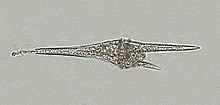Alveolate
| Alveolata Temporal range: Ediacaran - Recent |
|
|---|---|
 |
|
| Ceratium furca | |
| Scientific classification | |
| Domain: | Eukaryota |
| (unranked): | Sar |
| (unranked): |
Alveolata Cavalier-Smith, 1991 |
| Phyla | |
Apicomplexa
Chromerida
Ciliophora
Dinoflagellata
The alveolates (meaning "with cavities") are a group of protists, considered a major clade and superphylum within Eukarya, and are also called Alveolata.
The most notable shared characteristic is the presence of cortical alveoli, flattened vesicles packed into a continuous layer supporting the membrane, typically forming a flexible pellicle. In dinoflagellates they often form armor plates. Alveolates have with tubular cristae and their flagella or cilia have a distinct structure.
Almost all sequenced mitochondrial genomes of ciliates and apicomplexia are linear. The mitochondrial genome of Babesia microti is circular. This species is also now known not to belong to either of the genera Babesia or Theileria and a new genus will have to be created for it.
Alveolata comprises around 9 major and minor groups, which are very diverse in form, and are known to be related by various ultrastructural and genetic similarities:
The Acavomonidia and Colponemidia were previously grouped together as colponemids, a taxon now split based on ultrastructural analysis. The Acavomonidia are closer to the dinoflagellate/perkinsid group than the Colponemidia are. As such, the informal term "colponemids", as its stands currently, covers two non-sister groups within Alveolata: the Acavomonidia and the Colponemidia.
The Apicomplexa and dinoflagellates may be more closely related to each other than to the ciliates. Both have plastids, and most share a bundle or cone of microtubules at the top of the cell. In apicomplexans this forms part of a complex used to enter host cells, while in some colorless dinoflagellates it forms a peduncle used to ingest prey. Various other genera are closely related to these two groups, mostly flagellates with a similar apical structure. These include free-living members in Oxyrrhis and Colponema, and parasites in Perkinsus,Parvilucifera, Rastrimonas and the ellobiopsids. In 2001, direct amplification of the rRNA gene in marine picoplankton samples revealed the presence of two novel alveolate linages, called group I and II. Group I has no cultivated relatives, while group II is related to the dinoflagellate parasite Amoebophrya, which was classified until now in the Syndiniales dinoflagellate order.
...
Wikipedia
